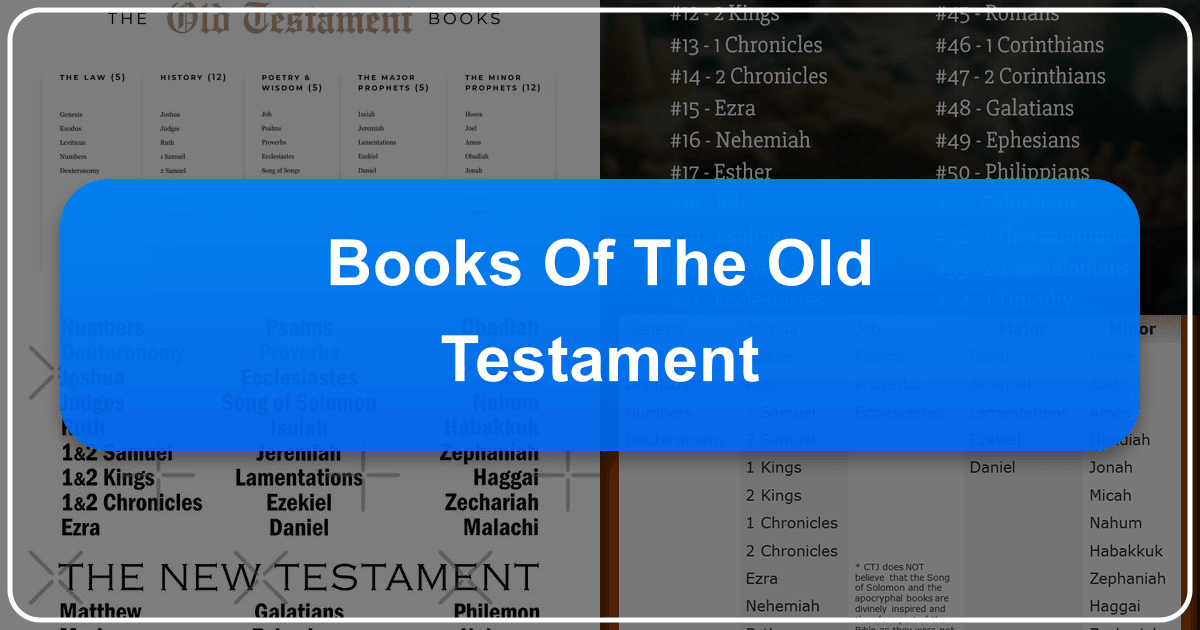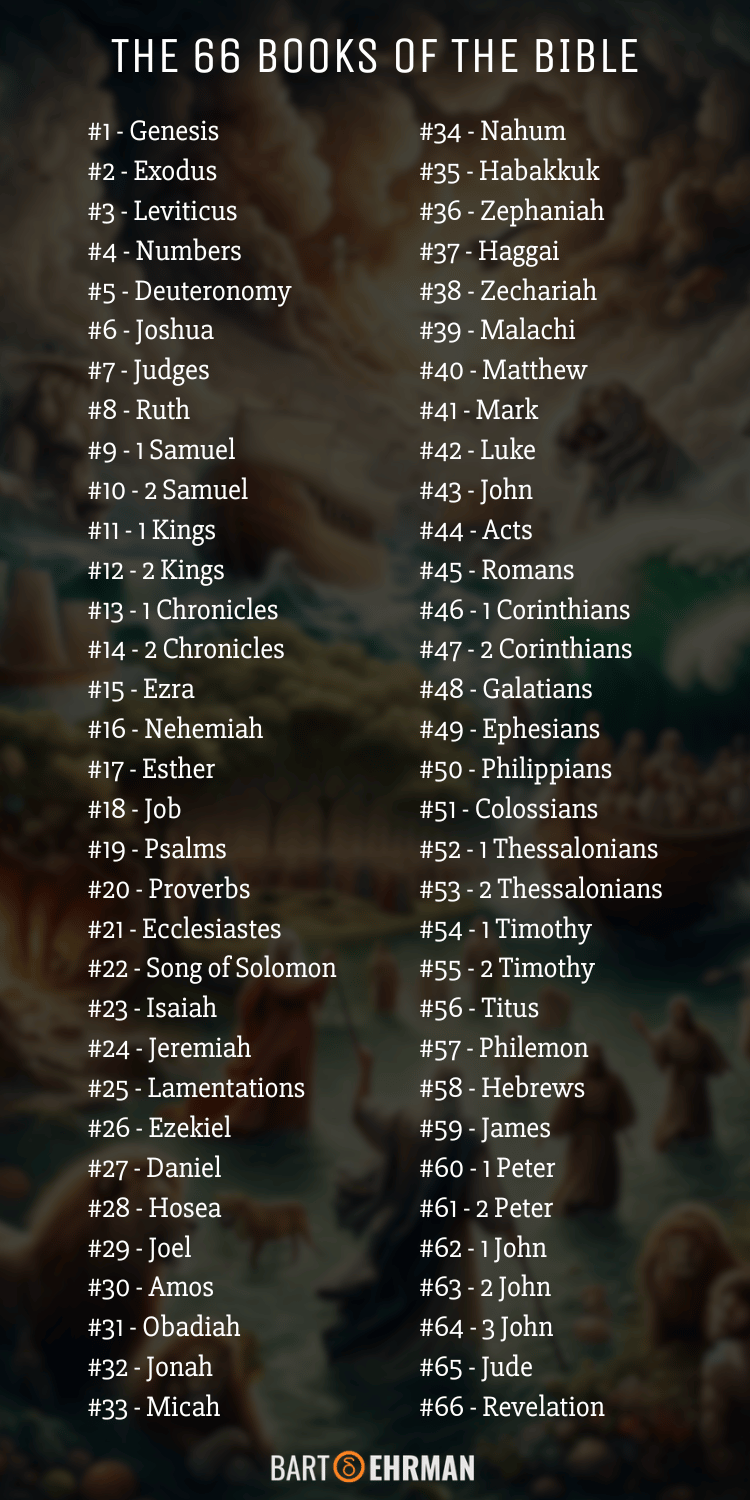The Books of the Old Testament: A Comprehensive Guide

The Old Testament, a cornerstone of Judaism and Christianity, comprises a rich collection of texts spanning centuries and diverse literary genres. Understanding its structure, authorship, and historical context is crucial for appreciating its enduring influence on religious thought and cultural expression. This comprehensive guide will explore the books of the Old Testament, categorized by genre, and delve into their authorship, historical background, key themes, and lasting cultural impact. We will draw upon scholarly perspectives while maintaining an objective approach, acknowledging the complexities and ongoing debates surrounding biblical scholarship.
1. Categorizing the Books of the Old Testament

The 39 books of the Old Testament are traditionally categorized into five main groups: the Law (Torah), the Historical Books, the Poetical Books (Wisdom Literature), the Major Prophets, and the Minor Prophets. This categorization reflects a historical development and thematic coherence within the collection. However, it’s important to note that modern biblical scholarship often challenges the traditional authorship and dating of these books, viewing them as products of complex literary and historical processes.
1.1 The Law (Torah): The Foundation of Jewish Law and Practice
The first five books – Genesis, Exodus, Leviticus, Numbers, and Deuteronomy – form the Torah, also known as the Pentateuch. Traditionally attributed to Moses, modern scholarship suggests a more complex authorship, spanning several centuries and possibly involving multiple authors. These books lay the foundation for Jewish law and practice, covering creation, the covenant with Abraham, the exodus from Egypt, the giving of the law at Mount Sinai, and the Israelites’ journey to the Promised Land. The Torah provides the ethical, legal, and ritual framework for Jewish life and serves as a foundational text for both Judaism and Christianity.

- Genesis (Beginning): Narrates creation, the fall of humanity, the patriarchs (Abraham, Isaac, Jacob, and Joseph), and the early history of the Israelite people.
- Exodus (Departure): Details the enslavement of the Israelites in Egypt, their liberation under Moses, the giving of the Ten Commandments, and the establishment of the covenant between God and His people.
- Leviticus (Concerning the Levites): Primarily focuses on laws and regulations concerning priestly duties, sacrifices, and ritual purity, emphasizing holiness and the proper worship of God.
- Numbers (Census): Recounts the census of the Israelites in the wilderness, their journeys, and various events, including rebellions and divine interventions.
- Deuteronomy (Second Law): Presents Moses’ final speeches to the Israelites before entering the Promised Land, reiterating the Law and emphasizing obedience, covenant faithfulness, and social justice.
1.2 The Historical Books: Narratives of the Israelite People
This section follows the Torah, chronicling the history of the Israelites from their conquest of Canaan to the Babylonian exile. These twelve books—Joshua, Judges, Ruth, 1 Samuel, 2 Samuel, 1 Kings, 2 Kings, 1 Chronicles, 2 Chronicles, Ezra, Nehemiah, and Esther—offer narratives of conquest, settlement, monarchy, division, and exile. The authorship and dating of these books are debated, with some scholars suggesting composite authorship spanning centuries. The narratives, however, provide valuable insights into the social, political, and religious life of ancient Israel.
- Joshua: Relates the conquest of Canaan under Joshua, the successor to Moses.
- Judges: Recounts a cycle of oppression and liberation under various Israelite judges.
- Ruth: A poignant story of loyalty, love, and redemption.
- 1 & 2 Samuel: Trace the establishment of the Israelite monarchy under Saul and David.
- 1 & 2 Kings: Detail the reigns of David’s successors, the division of the kingdom, and the eventual exile of Israel and Judah.
- 1 & 2 Chronicles: Offer parallel accounts of the reigns of David and the kings of Judah, emphasizing genealogy and religious aspects.
- Ezra & Nehemiah: Describe the return of the exiles from Babylon and the rebuilding of the Temple and Jerusalem walls.
- Esther: Narrates the story of Esther, a Jewish queen who saves her people from annihilation.
1.3 The Poetical Books (Wisdom Literature): Reflections on Life and God
This group encompasses five books—Job, Psalms, Proverbs, Ecclesiastes, and Song of Solomon—that explore various themes through poetry and wisdom literature. Their authorship and dating are often debated, with some traditionally attributed to Solomon. These books offer reflections on life, suffering, wisdom, justice, love, and the relationship between humanity and God. They provide profound insights into the human condition and offer guidance for living a meaningful life.
- Job: Explores the problem of suffering and the nature of justice.
- Psalms: A collection of hymns, prayers, and poems expressing a wide range of emotions and experiences.
- Proverbs: A compendium of wise sayings and instructions for righteous living.
- Ecclesiastes: A philosophical reflection on the meaninglessness of life without God.
- Song of Solomon: Celebrates romantic love, often interpreted allegorically in religious contexts.
1.4 The Prophetic Books: Messages of Judgment, Hope, and Restoration
The prophetic books contain messages delivered by prophets on behalf of God, conveying warnings, promises, and visions concerning Israel’s fate. They are divided into Major and Minor Prophets, based on the length of their books, not their relative importance. These books often address social injustices, idolatry, and the need for repentance, while also offering promises of restoration and the coming of a future messianic age.
1.4.1 Major Prophets: Isaiah, Jeremiah, Lamentations, Ezekiel, and Daniel. These books contain extensive prophetic pronouncements, often with detailed narratives and historical contexts.
- Isaiah: Offers messages of judgment, hope, and restoration, including prophecies about the Messiah.
- Jeremiah: Delivers warnings of judgment against Judah and Jerusalem, emphasizing the consequences of unfaithfulness to God’s covenant.
- Lamentations: A collection of poems mourning the destruction of Jerusalem.
- Ezekiel: Conveys messages of judgment and hope during the Babylonian exile.
- Daniel: Features narratives of Jewish resilience in Babylon alongside apocalyptic visions.
1.4.2 Minor Prophets: Hosea, Joel, Amos, Obadiah, Jonah, Micah, Nahum, Habakkuk, Zephaniah, Haggai, Zechariah, and Malachi. These twelve books, though shorter, convey significant prophetic messages, often addressing specific historical events and societal conditions.
- Hosea: Uses his troubled marriage as a metaphor for God’s relationship with Israel.
- Joel: Depicts a locust plague as a symbol of divine judgment and restoration.
- Amos: Denounces social injustice and idolatry in the Northern Kingdom.
- Obadiah: Prophesies the destruction of Edom.
- Jonah: Narrates the story of Jonah’s disobedience and God’s mercy.
- Micah: Condemns social injustice and predicts the coming of the Messiah from Bethlehem.
- Nahum: Proclaims the destruction of Nineveh.
- Habakkuk: Questions God’s justice in the face of suffering.
- Zephaniah: Announces the “Day of the Lord” and calls for repentance.
- Haggai: Urges the rebuilding of the Temple in Jerusalem.
- Zechariah: Offers visions and prophecies concerning the restoration of Jerusalem and the future messianic king.
- Malachi: Addresses issues of religious hypocrisy and calls for faithfulness to God.
2. Authorship and Dating: A Complex Landscape
Attributing specific authors and precise dates to the Old Testament books is a complex undertaking. Traditional attributions often rely on internal evidence and later traditions, but modern scholarship often questions these assumptions. The books likely emerged over centuries, with some representing compilations of oral traditions and written materials from different periods. The process of canonization—the selection and acceptance of books as authoritative scripture—also played a significant role in shaping the collection we have today. The differences in the number of books between the Protestant, Catholic, and Jewish canons reflect different criteria used for canonization.
3. The Cultural Impact of the Old Testament

The Old Testament has profoundly impacted Western culture, influencing literature, art, music, law, ethics, and religious thought for millennia. Its narratives, laws, prophecies, and wisdom literature have shaped Western civilization’s moral and spiritual values, providing rich source material for interpretations, adaptations, and ongoing theological reflection. The enduring influence of the Old Testament continues to resonate in contemporary society.
4. Exploring the Old Testament through Different Lenses
The Old Testament offers a wealth of material for readers with diverse interests. Whether focusing on historical narratives, legal codes, poetic reflections, or prophetic pronouncements, the texts provide multifaceted perspectives on human existence and the divine. Utilizing various resources such as summaries, commentaries, and scholarly works helps illuminate the nuances and complexities of these ancient texts, promoting a deeper understanding of their enduring value. Furthermore, examining the books’ intertextual relationships highlights their cohesive nature, unveiling deeper connections and revealing a consistent theological message.
5. The Old Testament in Modern Libraries and Digital Archives
Access to the Old Testament is readily available through various means, including print Bibles, digital libraries (such as those offered by Lbibinders.org), and online resources. These resources offer diverse translations, study aids, and scholarly commentary, fostering in-depth study and exploration. Digitization initiatives allow for increased accessibility and provide opportunities for collaborative research and textual analysis. This expanding access democratizes access to the Old Testament, ensuring its enduring relevance and accessibility for a global audience. Moreover, rare collections in physical libraries and archives provide opportunities for researchers to engage with manuscripts that represent the historical evolution of the Old Testament text.
This comprehensive overview serves as a starting point for engaging with the rich tapestry of the Old Testament. Further exploration will undoubtedly deepen your understanding and appreciation of this foundational collection of sacred literature.